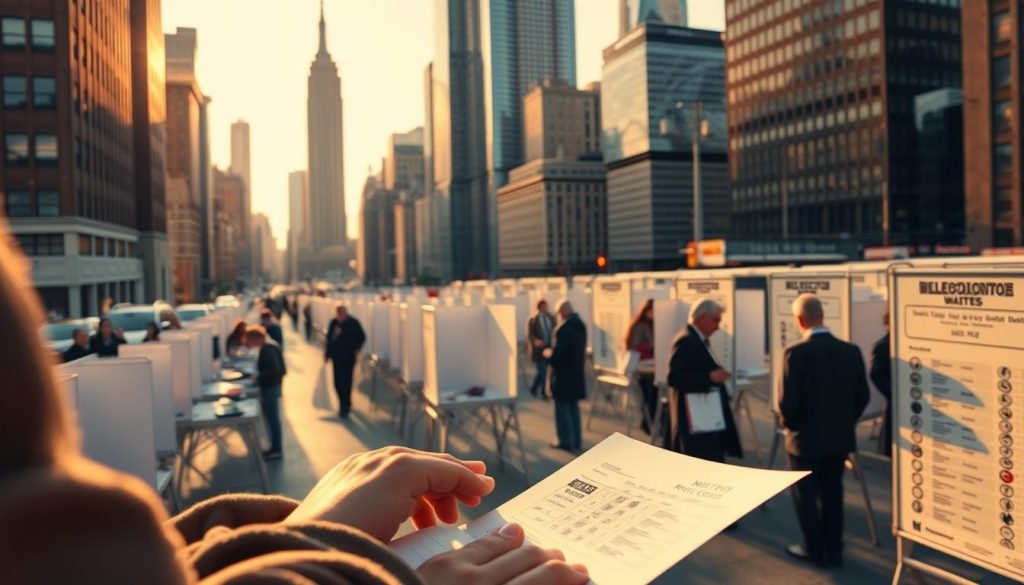The 2025 New York City Democratic Primary has brought significant changes to the local political landscape. Assemblymember Zohran Mamdani is poised to secure the Democratic nomination for mayor after former Gov. Andrew Cuomo conceded to him following the first round of ranked-choice primary votes.
With 89% of precincts reporting, Mamdani led with 44% of the first-choice votes, while Cuomo garnered 36%. The use of ranked-choice voting allowed voters to rank candidates in order of preference, potentially altering the outcome as votes were redistributed.
This primary election has reshaped local politics, with implications for policy direction on housing, transportation, and public safety.
Key Takeaways
- The 2025 NYC Democratic Primary has significantly reshaped local politics.
- Assemblymember Zohran Mamdani emerged as the frontrunner in the mayoral race.
- Ranked-choice voting was used, allowing voters to rank multiple candidates.
- Results from various races have established new political dynamics.
- The primary election saw strategic alliances and significant financial investments.
- Final certified results will be available in mid-July.
The 2025 NYC Democratic Primary Overview
The 2025 NYC Democratic Primary has concluded, marking a significant event in New York City’s political landscape. The primary election saw a considerable turnout, with voters participating across the five boroughs.
Key Races and Voter Participation
Voter participation was notable, with several key races drawing significant attention. Candidates made early morning appearances, including Mamdani’s 5:40 a.m. press conference in Astoria Park, where he emphasized the need for change in New York City.
- Candidates engaged with voters across different demographics.
- Election officials reported minimal disruptions to voting operations.
Election Day Highlights
On Election Day, polling sites reported steady turnout despite high temperatures. Exit polling indicated that economic concerns, housing affordability, and public safety were top issues for voters.
- First results began appearing shortly after polls closed at 9 p.m.
- Mamdani took an early lead, surprising many political observers.
Mamdani’s Surprising Lead in the Mayoral Race
Mamdani’s unexpected lead in the mayoral race has sent shockwaves through the New York election scene. The results have been closely watched, with many awaiting the outcome of the Democratic primary.
First-Round Results and Vote Counts
The initial round of voting revealed a competitive field, with Mamdani emerging as the frontrunner. The vote count showed a significant lead for Mamdani, setting the stage for a potentially contentious ranked-choice tabulation.
Cuomo’s Concession and Response
Former Governor Andrew Cuomo made a surprise appearance at his campaign headquarters in the Carpenters Union building on Manhattan’s west side to concede the race. “I want to applaud the Assemblyman for a really smart and good and impactful campaign. Tonight was his night. He deserved it. He won,” Cuomo said, flanked by his family. Cuomo has since petitioned to be on the general election ballot as an independent candidate.
The concession came despite the final ranked-choice tabulation not being complete, highlighting the significance of Mamdani’s lead in the New York mayoral race.
Understanding NYC Primary Ranked-Choice Voting
The 2025 NYC Democratic Primary is utilizing a ranked-choice voting system, a process that allows voters to rank candidates in order of preference. This system is designed to ensure that the winner is elected based on a majority of votes, rather than just a plurality.
How the System Works
The ranked-choice voting system works by allowing voters to rank candidates in order of preference. If no candidate receives a majority of first-choice votes, the candidate with the fewest votes is eliminated, and their votes are redistributed to the remaining candidates based on the next preference listed on each ballot.
Timeline for Final Results
The Board of Elections has established a multi-week timeline for processing and certifying the final results of the primary election. Key milestones include:
- Initial first-choice results were released on election night (June 24), including in-person votes and early processed mail ballots.
- A preliminary tabulation of ranked-choice voting results will be released on July 1.
- Absentee ballots with minor errors are returned to voters for correction, with a deadline of July 14 for these “cured” ballots to be returned and counted.
- Final certified results are expected in mid-July.
This timeline allows for the thorough processing and verification of all ballots, ensuring the accuracy and integrity of the election results.
Strategic Alliances: The Mamdani-Lander Coalition
The Mamdani-Lander coalition has emerged as a significant force in the NYC Democratic Primary. This alliance has brought together progressive voters and labor organizations, creating a strong base of support.
Cross-Endorsement Strategy
The cross-endorsement strategy employed by Mamdani and Lander has been effective in garnering support from various factions within the party. By endorsing each other, they have consolidated their voter base.
Working Families Party Support
The Working Families Party has played a crucial role in endorsing Mamdani and Lander, providing them with organizational support and volunteer resources. This backing has helped establish credibility with progressive voters.
- The WFP’s endorsement carries significant weight due to its ability to run candidates on its own ballot line.
- Mamdani’s campaign gained momentum with the WFP’s support, countering Cuomo’s institutional advantages.
Campaign Strategies and Ground Game
The 2025 NYC Democratic Primary witnessed a notable contrast in campaign strategies between Mamdani and Cuomo. The difference in their approaches significantly impacted their outreach and voter engagement.
Mamdani’s Grassroots Approach
Mamdani’s campaign was characterized by a grassroots, volunteer-driven strategy. This approach allowed for personal interactions with voters and fostered a strong community connection.
Cuomo’s Financial Advantage
Cuomo’s campaign, on the other hand, leveraged substantial financial resources. An independent expenditure group, “Fix the City,” contributed over $25 million to support Cuomo’s campaign, enabling extensive outreach through paid canvassers across New York City.
The contrast between Mamdani’s grassroots effort and Cuomo’s financially backed campaign highlighted the different paths to voter engagement in the city.
Public Advocate Race Results
In the recent NYC Democratic Primary, Jumaane Williams secured a significant win as Public Advocate. The election results show a decisive victory for Williams, highlighting strong voter support.
The Contest Between Williams and Rajkumar
The race was primarily between incumbent Jumaane Williams and Queens Assembly Member Jenifer Rajkumar. With 94.49% of scanners reporting, Williams garnered 71.29% of the votes (623,331 votes), while Rajkumar secured 18.71% (163,625 votes).
Margin of Victory and Voter Support
Williams’ commanding margin indicates strong voter satisfaction with his performance. The race did not require ranked-choice tabulation since Williams exceeded the 50% threshold in first-choice votes. Key statistics include:
- Incumbent Jumaane Williams: 71.29% (623,331 votes)
- Jenifer Rajkumar: 18.71% (163,625 votes)
- Marty Dolan: 9.39% (82,106 votes)
Comptroller Race: Levine vs. Brannan
As the NYC primary results roll in, the Comptroller race is shaping up to be a close contest between Mark Levine and Justin Brannan.
Leading Candidates and Platforms
Mark Levine, Manhattan Borough President, led the Comptroller race with 48.15% of the vote. Justin Brannan, Brooklyn City Council Member, secured 33.58%. Ismael Malave Perez and Kevin Parker trailed behind with 10.11% and 7.79%, respectively.
Vote Distribution Across Boroughs
Levine performed well in Manhattan and parts of the Bronx, while Brannan showed strength in Brooklyn and portions of Queens. With 94.49% of scanners reporting, the final outcome will be decided through ranked-choice voting.
- Mark Levine: 48.15% (424,578 votes)
- Justin Brannan: 33.58% (296,063 votes)
- Ismael Malave Perez: 10.11% (89,177 votes)
- Kevin Parker: 7.79% (68,695 votes)
Borough President Contests Across NYC
As part of the 2025 NYC Democratic Primary, voters decided on new Borough Presidents across the city. The elections saw varied outcomes in different boroughs.
Brooklyn and Bronx Results
In Brooklyn and the Bronx, the contests were closely watched. While detailed results are not yet available, these races are crucial for local governance.
Manhattan Borough President Race
In Manhattan, State Senator Brad Hoylman-Sigal led with 48.78% of the vote (120,261 votes) with 94.29% of scanners reporting. City Councilmember Keith Powers was second with 38.17% (94,098 votes). The race will likely be decided through ranked-choice voting as Hoylman-Sigal fell short of the 50% threshold.
District Attorney Races in Brooklyn and Manhattan
The District Attorney races in Brooklyn and Manhattan were closely watched during the NYC primary election. These races were significant as they reflect the ongoing debates about criminal justice reform and public safety.
Incumbents Defend Their Positions
Alvin Bragg, Manhattan’s first Black District Attorney, faced criticism for his progressive approach but maintained strong voter support. Incumbent District Attorneys in both boroughs defended their positions, with voters largely backing their continued leadership.
Voter Priorities in DA Races
Voter priorities in the District Attorney races included balancing public safety with criminal justice reform. Exit polls indicated that voters sought a balanced approach to prosecution, addressing systemic inequities while maintaining safety.
- Voters supported Bragg’s progressive approach despite some criticism.
- Strong turnout was observed in neighborhoods like Harlem and Bedford-Stuyvesant.
- The incumbent prosecutors’ strong showing indicated voter satisfaction with current criminal justice policies.
Key City Council Races and Outcomes
All 51 City Council seats were up for grabs in the primary, with several facing competitive challenges. The New York City Council primary elections saw significant competition across various districts.
Notable Incumbent Victories
Several incumbents secured victories in their respective districts. Incumbent Christopher Marte won in District 1 (Lower Manhattan) despite a strong challenge from Elizabeth Lewinsohn.
Competitive District Challenges
Districts experiencing demographic shifts saw intense competition. District 2 in Manhattan had a crowded field, with former Congressman Anthony Weiner receiving 10.34% of the vote. District 4 on Manhattan’s East Side featured a six-way race, setting up a complex ranked-choice tabulation.
Absentee Ballots and Remaining Vote Count
The outcome of the New York primary election hangs in the balance as absentee ballots are counted. The process is ongoing, with a significant number of ballots still to be processed.
Processing Timeline
The New York election board is working diligently to count the absentee ballots. One reason for the built-in delay is that the board returns absentee ballots with minor errors to voters so that they can fix any issues, such as unsigned envelopes. Voters must send those absentee ballots back by July 14 to be included in the official count.
Potential Impact on Close Races
The remaining uncounted ballots could significantly impact close races. Several City Council races with margins of less than 500 votes could see their outcomes change once all absentee and affidavit ballots are counted. Historically, absentee ballots tend to skew slightly more progressive than in-person votes, potentially benefiting certain candidates in the final tabulation.
- The Comptroller race between Mark Levine and Justin Brannan could be significantly affected by the remaining ballots.
- Absentee ballots with minor errors are returned to voters through a “cure” process, allowing them to fix issues by July 14.
Looking Ahead to the General Election
As the NYC primary comes to a close, the general election is on the horizon. The November general election is shaping up to be unusually competitive for New York City. Former Governor Andrew Cuomo and incumbent Mayor Eric Adams are set to appear on the ballot, potentially setting up a three-way race. The Working Families Party’s endorsement of Mamdani gives him an additional ballot line, potentially consolidating progressive support.
FAQ
What is ranked-choice voting, and how does it work in the NYC Democratic primary?
Ranked-choice voting is a system where voters rank candidates in order of preference. The candidate with the fewest first-choice votes is eliminated, and their votes are redistributed to the remaining candidates based on the next preference listed on each ballot.
How long does it take to count all the ballots in the NYC primary election?
The processing timeline for absentee ballots and remaining vote counts can take several days to a week after Election Day, depending on the volume of ballots and the efficiency of the election administration.
What are the key factors that influence voter participation in the NYC Democratic primary?
Voter participation is influenced by factors such as the competitiveness of the races, the candidates’ campaigns and outreach efforts, and the overall engagement of the electorate, particularly in key demographics.
How does the cross-endorsement strategy between Mamdani and Comptroller Brad Lander impact the mayoral race?
The cross-endorsement strategy between Mamdani and Comptroller Brad Lander aims to consolidate support and resources, potentially boosting their respective campaigns and increasing their chances of winning.
What are the implications of Gov. Andrew Cuomo’s concession on the Democratic primary?
Gov. Andrew Cuomo’s concession signals a shift in the dynamics of the primary, potentially affecting the momentum and viability of other candidates in the race.
How do the results of the Public Advocate and Comptroller races impact the broader NYC Democratic primary?
The outcomes of these key citywide offices can influence the balance of power within the city government and have implications for policy and governance in the city.
What role do district attorney races play in shaping the justice system in NYC?
District attorney races are critical in determining the approach to law enforcement and justice in their respective boroughs, with incumbents and challengers vying for voter support based on their platforms and track records.



